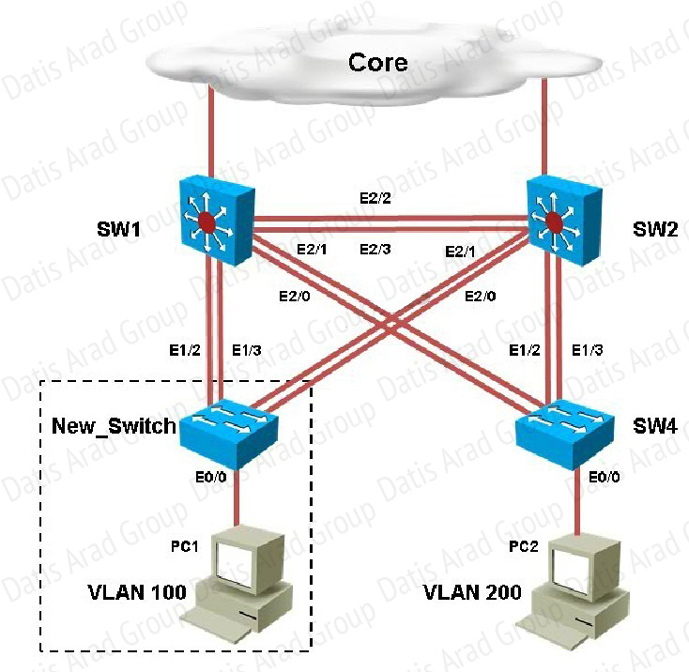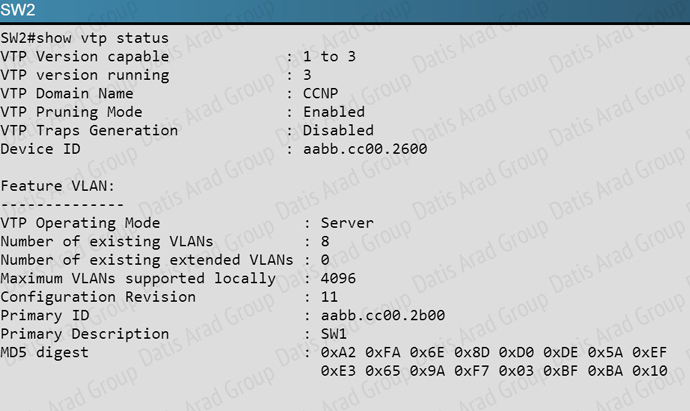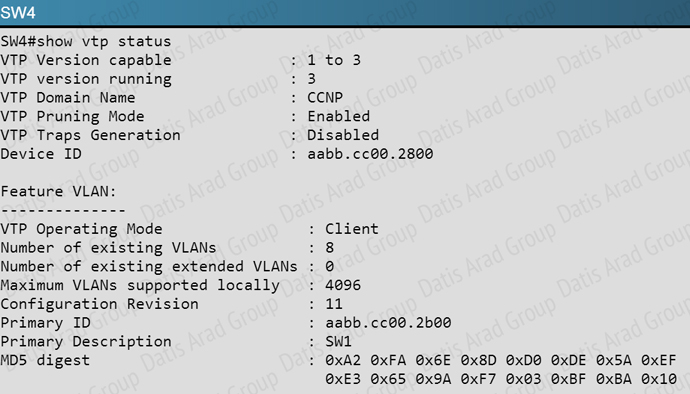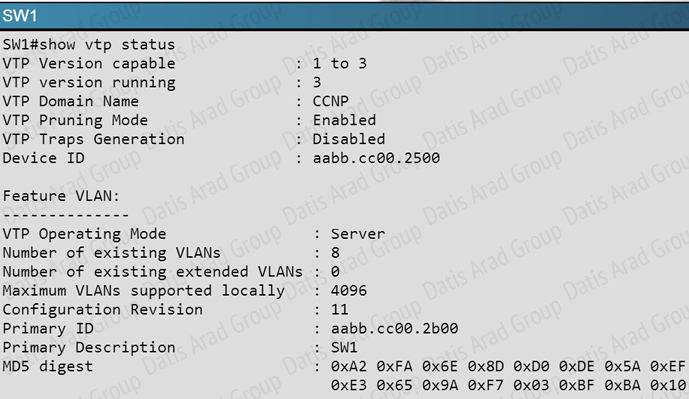
نمونه سوالات آزمون
Implementing Cisco IP Switched Networks - exam 300-115
Topic 1, Layer 2 Technologies
QUESTION NO: 101
You have been asked to install and configure a new switch in a customer network. Use the console access to the existing and new switches to configure and verify correct device configuration.
 You are connecting the New_Switch to the LAN topology; the switch has been partially configured and you need to complete the rest of configuration to enable PC1 communication with PC2. Which of the configuration is correct?
You are connecting the New_Switch to the LAN topology; the switch has been partially configured and you need to complete the rest of configuration to enable PC1 communication with PC2. Which of the configuration is correct?

A. Option A
B. Option B
C. Option C
D. Option D
E. Option E
Answer: D
Explanation:
Within any VTP, the VTP domain name must match. So, step one is to find the correct VTP name on the other switches. Logging in to SW1 and using the “show vtp status” command we see this:
So we know that the VTP domain must be CCNP. This leaves only choice D and E. We also see from the topology diagram that eth 0/0 of the new switch connects to a PC in VLNA 100, so we know that this port must be an access port in VLAN 100, leaving only choice D as correct. Note that the VTP versions supported in this network are 1, 2, 3 so either VTP version 2 or 3 can be configured on the new switch.
QUESTION NO: 102
You have been asked to install and configure a new switch in a customer network. Use the console access to the existing and new switches to configure and verify correct device configuration.
 Refer to the configuration. For which configured VLAN are untagged frames sent over trunk between SW1 and SW2?
Refer to the configuration. For which configured VLAN are untagged frames sent over trunk between SW1 and SW2?
A. VLAN1
B. VLAN 99
C. VLAN 999
D. VLAN 40
E. VLAN 50
F. VLAN 200
G. VLAN 300
Answer: B
Explanation:
The native VLAN is used for untagged frames sent along a trunk. By issuing the “show interface trunk” command on SW1 and SW2 we see the native VLAN is 99.


QUESTION NO: 103
You have been asked to install and configure a new switch in a customer network. Use the console access to the existing and new switches to configure and verify correct device configuration.
You are adding new VLANs. VLAN500 and VLAN600 to the topology in such way that you need to configure SW1 as primary root for VLAN 500 and secondary for VLAN 600 and SW2 as primary root for VLAN 600 and secondary for VLAN 500. Which configuration step is valid?
A. Configure VLAN 500 & VLAN 600 on both SW1 & SW2
B. Configure VLAN 500 and VLAN 600 on SW1 only
C. Configure VLAN 500 and VLAN 600 on SW2 only
D. Configure VLAN 500 and VLAN 600 on SW1 ,SW2 and SW4
E. On SW2; configure vtp mode as off and configure VLAN 500 and VLAN 600; configure back to vtp server mode.
Answer: A
Explanation:
By issuing the “show vtp status command on SW2, SW2, and SW4 we see that both SW1 and SW2 are operating in VTP server mode, but SW4 is a client, so we will need to add both VLANs to SW1 and SW2.



QUESTION NO: 104
You have been asked to install and configure a new switch in a customer network. Use the console access to the existing and new switches to configure and verify correct device configuration.
 Examine the VTP configuration. You are required to configure private VLANs for a new server deployment connecting to the SW4 switch. Which of the following configuration steps will allow creating private VLANs?
Examine the VTP configuration. You are required to configure private VLANs for a new server deployment connecting to the SW4 switch. Which of the following configuration steps will allow creating private VLANs?
A. Disable VTP pruning on SW1 only
B. Disable VTP pruning on SW2 only
C. Disable VTP pruning on SW4 only
D. Disable VTP pruning on SW2, SW4 and New_Switch
E. Disable VTP pruning on New_Switch and SW4 only.
Answer: C
Explanation:
To create private VLANs, you will need to only disable pruning on the switch that contains the private VLANs. In this case, only SW4 will connect to servers in a private VLAN.
Topic 2, Infrastructure Security
QUESTION NO: 105
A Cisco Catalyst switch that is prone to reboots continues to rebuild the DHCP snooping database. What is the solution to avoid the snooping database from being rebuilt after every device reboot?
A. A DHCP snooping database agent should be configured.
B. Enable DHCP snooping for all VLANs that are associated with the switch.
C. Disable Option 82 for DHCP data insertion.
D. Use IP Source Guard to protect the DHCP binding table entries from being lost upon rebooting.
E. Apply ip dhcp snooping trust on all interfaces with dynamic addresses.
Answer: A
Explanation:
Minimum DHCP Snooping Configuration
The minimum configuration steps for the DHCP snooping feature are as follows:
1. Define and configure the DHCP server.
2. Enable DHCP snooping on at least one VLAN.
By default, DHCP snooping is inactive on all VLANs.
3. Ensure that DHCP server is connected through a trusted interface.
By default, the trust state of all interfaces is untrusted.
4. Configure the DHCP snooping database agent.
This step ensures that database entries are restored after a restart or switchover.
5. Enable DHCP snooping globally.
QUESTION NO: 106
Which portion of AAA looks at what a user has access to?
A. authorization
B. authentication
C. accounting
D. auditing
Answer: A
Explanation:
These three ports show that they are in Port Channel 1, and the (SU) means they are in use and operating at layer 2. The protocol used for this port channel shows as LACP, which is a standards based protocol, as opposed to PAgP, which is Cisco proprietary.
QUESTION NO: 107
Which command creates a login authentication method named "login" that will primarily use RADIUS and fail over to the local user database?
A. (config)# aaa authentication login default radius local
B. (config)# aaa authentication login login radius local
C. (config)# aaa authentication login default local radius
D. (config)# aaa authentication login radius local
Answer: B
Explanation:
In the command “aaa authentication login login radius local” the second login is the name of the AAA method. It also lists radius first then local, so it will primarily use RADIUS for authentication and fail over to the local user database only if the RADIUS server is unreachable.
QUESTION NO: 108
A server with a statically assigned IP address is attached to a switch that is provisioned for DHCP snooping. For more protection against malicious attacks, the network team is considering enabling dynamic ARP inspection alongside DHCP snooping. Which solution ensures that the server maintains network reachability in the future?
A. Disable DHCP snooping information option.
B. Configure a static DHCP snooping binding entry on the switch.
C. Trust the interface that is connected to the server with the ip dhcp snooping trust command.
D. Verify the source MAC address of all untrusted interfaces with ip dhcp snooping verify macaddress command.
Answer: B
Explanation:
Dynamic ARP inspection is a security feature that validates ARP packets in a network. It intercepts, logs, and discards ARP packets with invalid IP-to-MAC address bindings. This capability protects the network from certain man-in-the-middle attacks.
Dynamic ARP inspection ensures that only valid ARP requests and responses are relayed. The switch performs these activities:
• Intercepts all ARP requests and responses on untrusted ports
• Verifies that each of these intercepted packets has a valid IP-to-MAC address binding before
updating the local ARP cache or before forwarding the packet to the appropriate destination.
• Drops invalid ARP packets
Dynamic ARP inspection determines the validity of an ARP packet based on valid IP-to MAC address bindings stored in a trusted database, the DHCP snooping binding database. This database is built by DHCP snooping if DHCP snooping is enabled on the VLANs and on the switch. If the ARP packet is received on a trusted interface, the switch forwards the packet without any checks. On untrusted interfaces, the switch forwards the packet only if it is valid. To ensure network reachability to the server, configure a static DHCP snooping binding entry on the switch.
QUESTION NO: 109
A network engineer wants to ensure Layer 2 isolation of customer traffic using a private VLAN. Which configuration must be made before the private VLAN is configured?
A. Disable VTP and manually assign VLANs.
B. Ensure all switches are configured as VTP server mode.
C. Configure VTP Transparent Mode.
D. Enable VTP version 3.
Answer: C
Explanation:
You must configure VTP to transparent mode before you can create a private VLAN. Private VLANs are configured in the context of a single switch and cannot have members on other switches. Private VLANs also carry TLVs that are not known to all types of Cisco switches.
QUESTION NO: 110
A DHCP configured router is connected directly to a switch that has been provisioned with DHCP snooping. IP Source Guard with the ip verify source port-security command is configured under the interfaces that connect to all DHCP clients on the switch. However, clients are not receiving an IP address via the DHCP server. Which option is the cause of this issue?
A. The DHCP server does not support information option 82.
B. The DHCP client interfaces have storm control configured.
C. Static DHCP bindings are not configured on the switch.
D. DHCP snooping must be enabled on all VLANs, even if they are not utilized for dynamic address allocation.
Answer: A
Explanation:
When you enable both IP Source Guard and Port Security, using the ip verify source port-security interface configuration command, there are two caveats:
• The DHCP server must support option 82, or the client is not assigned an IP address.
• The MAC address in the DHCP packet is not learned as a secure address. The MAC address of the DHCP client is learned as a secure address only when the switch receives non-DHCP data traffic.
QUESTION NO: 111
A switch is added into the production network to increase port capacity. A network engineer is configuring the switch for DHCP snooping and IP Source Guard, but is unable to configure ip verify source under several of the interfaces. Which option is the cause of the problem?
A. The local DHCP server is disabled prior to enabling IP Source Guard.
B. The interfaces are configured as Layer 3 using the no switchport command.
C. No VLANs exist on the switch and/or the switch is configured in VTP transparent mode.
D. The switch is configured for sdm prefer routing as the switched database management template.
E. The configured SVIs on the switch have been removed for the associated interfaces.
Answer: B
Explanation:
IP source guard is a security feature that restricts IP traffic on nonrouted, Layer 2 interfacesby filtering traffic based on the DHCP snooping binding database and on manually configured IP source bindings. You can use IP source guard to prevent traffic attacks caused when a host tries to use the IP address of its neighbor.
You can enable IP source guard when DHCP snooping is enabled on an untrusted interface. After IP source guard is enabled on an interface, the switch blocks all IP traffic received on the interface, except for DHCP packets allowed by DHCP snooping. A port access control list (ACL) is applied to the interface. The port ACL allows only IP traffic with a source IP address in the IP source binding table and denies all other traffic.
The IP source binding table has bindings that are learned by DHCP snooping or are manually configured (static IP source bindings). An entry in this table has an IP address, its associated MAC address, and its associated VLAN number. The switch uses the IP source binding table only when IP source guard is enabled.
IP source guard is supported only on Layer 2 ports, including access and trunk ports.You can configure IP source guard with source IP address filtering or with source IP and MAC address filtering.
QUESTION NO: 112
The command storm-control broadcast level 75 65 is configured under the switch port connected to the corporate mail server. In which three ways does this command impact the traffic? (Choose three.)
A. SNMP traps are sent by default when broadcast traffic reaches 65% of the lower-level threshold.
B. The switchport is disabled when unicast traffic reaches 75% of the total interface bandwidth.
C. The switch resumes forwarding broadcasts when they are below 65% of bandwidth.
D. Only broadcast traffic is limited by this particular storm control configuration.
E. Multicast traffic is dropped at 65% and broadcast traffic is dropped at 75% of the total interface bandwidth.
F. The switch drops broadcasts when they reach 75% of bandwidth.
Answer: C,D,F
Explanation:
storm-control{broadcast|multicast|unicast}level{level[level-low] |ppspps[pps-low]} Configure broadcast, multicast, or unicast storm control. By default, storm control is disabled. The keywords have these meanings:
• For level, specify the rising threshold level for broadcast, multicast, or unicast traffic as a percentage (up to two decimal places) of the bandwidth. The port blocks traffic when the rising threshold is reached. The range is 0.00 to 100.00.
• (Optional) For level-low, specify the falling threshold level as a percentage (up to two decimal places) of the bandwidth. This value must be less than or equal to the rising suppression value. The port forwards traffic when traffic drops below this level. If you do not configure a falling suppression level, it is set to the rising suppression level. The range is 0.00 to 100.00.
In this case, the broadcast keyword was used so only broadcast traffic is limited.
QUESTION NO: 113
After port security is deployed throughout an enterprise campus, the network team has been overwhelmed with port reset requests. They decide to configure the network to automate the process of re-enabling user ports. Which command accomplishes this task?
A. switch(config)# errdisable recovery interval 180
B. switch(config)# errdisable recovery cause psecure-violation
C. switch(config)# switchport port-security protect
D. switch(config)# switchport port-security aging type inactivity
E. switch(config)# errdisable recovery cause security-violation
Answer: B
Explanation:
When a secure port is in the error-disabled state, you can bring it out of this state automatically by configuring the errdisable recovery cause psecure-violation global configuration command or you can manually reenable it by entering the shutdown and no shut down interface configuration commands. This is the default mode. If a port is in per-VLAN errdisable mode, you can also use clear errdisable interface name vlan range command to re-enable the VLAN on the port. You can also customize the time to recover from the specified error disable cause (default is 300 seconds) by entering the errdisable recovery interval interval command.
QUESTION NO: 114
The network monitoring application alerts a network engineer of a client PC that is acting as a rogue DHCP server. Which two commands help trace this PC when the MAC address is known? (Choose two.)
A. switch# show mac address-table
B. switch# show port-security
C. switch# show ip verify source
D. switch# show ip arp inspection
E. switch# show mac address-table address <mac address>
Answer: A,E
Explanation:
QUESTION NO: 115
While troubleshooting a network outage, a network engineer discovered an unusually high level of broadcast traffic coming from one of the switch interfaces. Which option decreases consumption of bandwidth used by broadcast traffic?
A. storm control
B. SDM routing
C. Cisco IOS parser
D. integrated routing and bridging
E. Dynamic ARP Inspection
Answer: A
Explanation:
Storm control prevents traffic on a LAN from being disrupted by a broadcast, multicast, or unicast storm on a port. A LAN storm occurs when packets flood the LAN, creating excessive traffic and degrading network performance. Errors in the protocol-stack implementation, mistakes in network configuration, or users issuing a denial-of-service attack can cause a storm.
Storm control is configured for the switch as a whole but operates on a per-port basis. By default, storm control is disabled.
Storm control uses rising and falling thresholds to block and then restore the forwarding of broadcast, unicast, or multicast packets. You can also set the switch to shut down the port when the rising threshold is reached.
QUESTION NO: 116
Which command globally enables AAA on a device?
A. aaa new-model
B. aaa authentication
C. aaa authorization
D. aaa accounting
Answer: A
Explanation:
To configure AAA authentication, enable AAA by using the aaa new-model global configuration command. AAA features are not available for use until you enable AAA globally by issuing the aaa new-model command.
QUESTION NO: 117
Which AAA Authorization type includes PPP, SLIP, and ARAP connections?
A. network
B. IP mobile
C. EXEC
D. auth-proxy
Answer: A
Explanation:
Method lists for authorization define the ways that authorization will be performed and the sequence in which these methods will be performed. A method list is simply a named list describing the authorization methods to be queried (such as RADIUS or TACACS+), in sequence. Method lists enable you to designate one or more security protocols to be used for authorization, thus ensuring a backup system in case the initial method fails. Cisco IOS software uses the first method listed to authorize users for specific network services; if that method fails to respond, the Cisco IOS software selects the next method listed in the method list. This process continues until there is successful communication with a listed authorization method, or all methods defined are exhausted.
Method lists are specific to the authorization type requested:
• Auth-proxy—Applies specific security policies on a per-user basis. For detailed information on the authentication proxy feature, refer to the chapter "Configuring Authentication Proxy" in the "Traffic Filtering and Firewalls" part of this book.
• Commands—Applies to the EXEC mode commands a user issues. Command authorization attempts authorization for all EXEC mode commands, including global configuration commands, associated with a specific privilege level.
• EXEC—Applies to the attributes associated with a user EXEC terminal session.
• Network—Applies to network connections. This can include a PPP, SLIP, or ARAP connection.
• Reverse Access—Applies to reverse Telnet sessions. When you create a named method list, you are defining a particular list of authorization methods for the indicated authorization type.
QUESTION NO: 118
Which authentication service is needed to configure 802.1x?
A. RADIUS with EAP Extension
B. TACACS+
C. RADIUS with CoA
D. RADIUS using VSA
Answer: A
Explanation:
With 802.1x, the authentication server—performs the actual authentication of the client. The authentication server validates the identity of the client and notifies the switch whether or not theclient is authorized to access the LAN and switch services. Because the switch acts as the proxy, the authentication service is transparent to the client.The Remote Authentication Dial-In User Service (RADIUS) security system with Extensible Authentication Protocol (EAP) extensions is the only supported authentication server.
QUESTION NO: 119
Refer to the exhibit.

Which login credentials are required when connecting to the console port in this output?
A. none required
B. username cisco with password cisco
C. no username with password linepass
D. login authentication default
Answer: A
Explanation:
Here the console has been configured with the NO_AUTH name, which lists none as the authentication method. None means no authentication, meaning that credentials are not required and all sessions are allowed access immediately.
QUESTION NO: 120
Refer to the exhibit.

When a network administrator is attempting an SSH connection to the device, in which order does the device check the login credentials?
A. RADIUS server, local username, line password
B. RADIUS server, line password, local username
C. Line password, local username, RADIUS server
D. Line password, RADIUS server, local username
Answer: A
Explanation:
SSH sessions use the vty lines, where the configured authentication method is named “default.” The AAA default login preference is stated in order from first to last, so here the “aaa authentication login default group radius local line” means to use RADIUS first, then if that fails use the local user database. Finally, if that fails use the line password.
